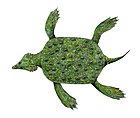神河龙属
| 神河龙属 化石时期:白垩纪晚期,
| |
|---|---|

| |
| 科学分类 | |
| 界: | 动物界 Animalia |
| 门: | 脊索动物门 Chordata |
| 纲: | 爬行纲 Reptilia |
| 目: | †蛇颈龙目 Plesiosauria |
| 科: | †薄板龙科 Elasmosauridae |
| 演化支: | †真薄板龙类 Euelasmosaurida |
| 亚科: | †薄板龙亚科 Elasmosaurinae |
| 属: | †神河龙属 Styxosaurus Welles, 1943 |
| 模式种 | |
| 史诺氏神河龙 Styxosaurus snowii (Williston, 1890)
| |
| 其他物种 | |
| |
| 异名 | |
| |
神河龙属(属名:Styxosaurus)是蛇颈龙亚目薄板龙科的一属,生存于白垩纪晚期(桑托阶到坎潘阶)的北美洲。
神河龙意为“冥河的蜥蜴”,是以希腊神话中的斯堤克斯河(River Styx)为名。斯堤克斯河是环绕冥界的九条冥河之一。
分类
[编辑]神河龙的模式标本(编号KUVP 1301 (页面存档备份,存于互联网档案馆))是在1867年发现于堪萨斯州洛根县的海尔河组,包含一个完整的头骨,以及20节颈椎[1]。在1890年,S.W. Williston将这个标本归类于白垩龙的一个种(Cimoliasaurus snowii)[2][3]。
在1906年,S. E. Williston将C. snowii改归类于薄板龙的一个种(Elasmosaurus snowii)[4]。在1943年,塞缪尔·保罗·威尔士将这个标本建立为新属,神河龙(Styxosaurus snowii)[5]。
在1945年,南达科塔州莱曼郡发现另一个更完整的标本(编号SDSMT 451 (页面存档备份,存于互联网档案馆)),身长约11米。在1949年,这个标本被归类于Alzadasaurus pembertoni。在1999年,肯尼思·卡彭特(Kenneth Carpenter)提出这个标本也属于神河龙的模式种,因此A. pembertoni成为S. snowii的异名[6]。
在1952年,威尔士建立第二个种,Styxosaurus browni。在1999年,这个种被发现是咸渊龙Hydralmosaurus的异名[6]。
食性
[编辑]编号SDSMT 451标本目前是南达科塔矿业及理工学院的展出物之一,被架设成颈部高举的姿态,但根据蛇颈龙类的颈部结构,牠们无法做出这种动作。这个标本的腹腔有约250颗胃石[7][8]。一个发现于堪萨斯州皮耳页岩的神河龙标本,腹腔则有鱼类化石与胃石[9]。大部分掠食动物不会吞食胃石以协助磨碎食物,但大部分较完整的蛇颈龙类标本,都发现胃石的存在。蛇颈龙类可能吞食胃石做为压载物,以协助身体的下沉。根据估计,蛇颈龙类标本中的胃石重量,少于动物本身重量的1%[10]。
在2006年,Oliver Wings提出不同看法,他认为鳄鱼与某些动物也可能吞食胃石作为压载物,而蛇颈龙类则可能吞食胃石以协助磨碎食物[11]。
叙述
[编辑]神河龙是种大型蛇颈龙类,生存于白垩纪晚期,属于薄板龙科。薄板龙科的颈部相当长,约占身长的一半,颈椎多达60到72节。
神河龙的身长约11到12米,颈部占身长的一半[12]。神河龙具有圆锥状的锐利牙齿,适合刺穿,而非切割[12]。如同其他蛇颈龙类,神河龙可能将猎物以大块吞下[12]。
大众文化
[编辑]在国家地理杂志的立体电影《与海怪同行:史前探险》(Sea Monsters: A Prehistoric Adventure),神河龙与数种海生爬行动物共同出现。
参考资料
[编辑]- ^ Structure of the Plesiosaurian skull structure of the Plesiosaurian skull 请检查
|url=值 (帮助). [2008-03-03]. (原始内容存档于2020-10-20). - ^ Williston, S. W. 1890a. Structure of the plesiosaurian skull. Science 16(407):290.
- ^ Williston, S. W. 1890b. A new plesiosaur from the Niobrara Cretaceous of Kansas. Kansas Academy Science, Transactions 7:174-178, with 2 fig.
- ^ Williston, S. W. 1906. "North American Plesiosaurs: Elasmosaurus, Cimoliasaurus, and Polycotylus". American Journal of Science 4(21):221-236.
- ^ Welles, S. P. 1943. Elasmosaurid plesiosaurs with a description of the new material from California and Colorado. University of California Memoirs 13:125-254. figs.1-37., pls.12-29.
- ^ 6.0 6.1 Carpenter, K. 1999. Revision of North American elasmosaurs from the Cretaceous of the western interior. Paludicola 2(2):148-173.
- ^ Everhart, M. J. 2005a. Oceans of Kansas - A Natural History of the Western Interior Sea. Indiana University Press, 320 pp.
- ^ oceansofkansas.com. [2008-02-21]. (原始内容存档于2019-12-28).
- ^ Cicimurri, D. J. and M. J. Everhart, 2001. An elasmosaur with stomach contents and gastroliths from the Pierre Shale (late Cretaceous) of Kansas. Kansas Acad. Sci. Trans 104(3-4):129-143.
- ^ Everhart, M. J. 2000. Gastroliths associated with plesiosaur remains in the Sharon Springs Member of the Pierre Shale (Late Cretaceous), western Kansas. Kansas Academy of Science, Transactions 103(1-2): 58-69.
- ^ Wings, Oliver (2004): Identification, distribution, and function of gastroliths in dinosaurs and extant birds with emphasis on ostriches (Struthio camelus). Ph.D. Thesis, The University of Bonn, Bonn, Germany, 187 pp. URN: urn:nbn:de:hbz:5N-04626 PDF fulltext Archive.is的存档,存档日期2007-07-16
- ^ 12.0 12.1 12.2 National Geiographic "Styxosaurus". [2008-02-21]. (原始内容存档于2017-01-25).
外部链接
[编辑]- Styxosaurus (页面存档备份,存于互联网档案馆) at Oceans of Kansas
- Styxosaurus (页面存档备份,存于互联网档案馆) at National Geographic







